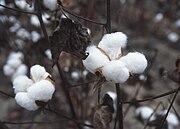
Back قطن عضوي Arabic Organic Cotton German Algodón ecológico Spanish Kotoi organiko Basque Kapas organik ID オーガニックコットン Japanese 有機棉 Chinese

| Cotton |
|---|
 |
| History |
| Terminology |
| Types |
| Production |
| Fabric |
| Part of a series on |
| Clothing and the environment |
|---|
| Environmental impact of fashion |
Organic cotton is generally defined as cotton that is grown organically in subtropical countries such as India, Turkey, China, and parts of the USA from non-genetically modified plants, and without the use of any synthetic agricultural chemicals such as fertilizers or pesticides[1] aside from the ones allowed by the certified organic labeling. Its production is supposed to promote and enhance biodiversity and biological cycles.[2] In the United States, cotton plantations must also meet the requirements enforced by the National Organic Program (NOP) from the USDA in order to be considered organic. This institution determines the allowed practices for pest control, growing, fertilizing, and handling of organic crops.[3]
As of 2007[update], 265,517 bales of organic cotton were produced in 24 countries and worldwide production was growing at a rate of more than 50% per year.[4] In the 2016/2017 season, annual global production reached 3.2 million metric tonnes.[5][6]
- ^ "CCVT Sustainable". Archived from the original on 2009-06-23. Retrieved 2009-12-02.
- ^ VineYardTeam Econ Archived July 5, 2008, at the Wayback Machine
- ^ AMSv1
- ^ "Organic Cotton Facts". The Organic Trade Association. Archived from the original on 2014-11-20. Retrieved 2016-07-11.
- ^ Mowbray, John (12 October 2017). "India drags on organic cotton volumes". MCL News & Media. Ecotextile. Retrieved 11 December 2017.
- ^ Organic Cotton Market Report 2017 (PDF) (Report). Textile Exchange. 2017.
© MMXXIII Rich X Search. We shall prevail. All rights reserved. Rich X Search